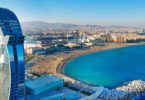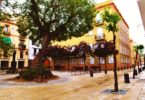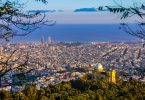A large part of the city of Barcelona is better known as the 22@ District. It was developed as an ambitious project to become the city’s hub for innovative technology companies.
This area was originally the center of the Catalan industrial revolution, but at the end of the 20th century it was decided that the neighbourhood of Poblenou needed to be modernised.
After years of urban planning and constructing new buildings, the district is now home to many major company headquarters, and there are still plans for future growth.
Table of Contents
Where in Barcelona is 22@?
This part of Barcelona is located in the district of Sant Marti, and more specifically it includes the neighbourhouds of Poblenou, Llacuna del Poblenou and Provençals del Poblenou.
The 22@ district runs from Plaça de les Glòries, from both sides of the Diagonal and almost to the beach. If you would like to know more of the area, please read this article about the 22@ district and Plaça de les Glòries.



Photo of Carrer Pere IV in Poblenou
The focus of Barcelona’s 22@ technological district
The area was developed to increase the city’s economic growth. That is why this part of Barcelona is also known as the technological district.
Besides its main focus on large technology companies, this part of Poblenou also includes residential areas, green zones, and many services and amenities for the people that live there.
During the restructuring period they managed to preserve the district’s architectural heritage. This means the original spirit and industrial characteristics are still visible.
The best monthly rentals in Barcelona
Living in Barcelona’s 22@ district
Will you be coming to Barcelona’s 22@ district for work or education purposes? Then check out our extensive portfolio with apartments in the three neighbourhoods in the district.
Have a look at some of the apartments in Poblenou, or rent your next home in Llacuna del Poblenou if you prefer living closer to Plaça de les Glòries. If you go to the other side of the Diagonal (north of this large street), you can find rentals in Provençals del Poblenou.
A list of companies in Barcelona’s 22@
Why would a city design a whole district around the subject of innovation? Well, there was a clear objective: wherever there are businesses, there is an interaction with people.
This automatically generates new interest and leads to the creation of more companies and entrepreneurial activities.
Some of the most renowned companies located in Barcelona’s 22@ district are:
- Mediapro
- Thoughtworks Spain
- Adevinta
- Aenor
- Amazon
- Cisco Systems
- T-Systems
If you visit the official 22@Network association’s website, you will see every company that is located within the 22@ district in Barcelona.



Photo of Poblenou’s Torre Glories
Universities and schools in the 22@ district
One other pillar for the development of Barcelona’s 22@ district was to create knowledge, so this resulted in several universities and educational facilities opening up branches in this part of Barcelona.
- Universitat Pompeu Fabra (UPF)
- Universitat de Barcelona – Institut de Formació Contínua (UB – IL3)
- Centro de Diseño de Barcelona (BAU)
- Estudis de Ciències de la Salut (UOC)
- Escuela de Negocios Europea de Barcelona (ENEB)
For more information on the city’s educational institutions, please check this article on the best neighbourhoods in the city for students, more in particular, the area of Sant Marti.
With the same target of educating people in mind, Barcelona City Council is contributing by facilitating important centers in each neighbourhood. The centers aim at entrepreneurship and training for locals.
Read this article if you are interested in what Barcelona Activa is and what it has to offer at the 22@ location.
Related article: Barcelona’s District of Sant Martí and its History
Futuristic buildings in Barcelona’s 22@ district
Another interesting fact is the reconstruction of the zone by adding several modern buildings in the 22@ district. New urban planning was the main attraction for many innovative architectural projects.
Walking through the streets of this district will show you what the future of architecture has to offer. Some of the most characteristic structures are now:
- Torre Glories by architect Jean Nouvel
- Barcelona Growth Center (previously known as Media TIC) by architect Enric Ruiz Geli
- Comisión del Mercado de las Telecomunicaciones (CMT building) by architects Enric Battle and Joan Roig
- Can Framis factory, now the Can Framis museum and remodeled by architect Jordi Badia
- Imagina-Mediapro building by architects Carles Ferrater, Patrick Genard and Xavier Martí
- Interface office building, also by architects Enric Battle and Joan Roig
The effect of teleworking on the 22@ offices
November 2020 marked the 20th anniversary of the 22@ urban planning project, and it has been the start of new developments.
Barcelona’s City Council is still continuing to promote the 22@ district, and within the “Plan General Metropolitano” (the general city plan) the area has been designated as Barcelona’s technological district.
Municipal government is, however, suggesting three major differences to the initial plan developed in 1999.
Greater diversity in companies
The first difference is that local government wants to open up and welcome all kinds of companies to the business district.
The authorities are now investigating whether companies in the field of new technologies and companies focussed on green or solidarity-based economies are interested in moving here.
To attract these companies, subsidy plans for buildability are offered, and these worked the first time the 22@ project started, so it is expected that this stimulus will work again.
Teleworking has resulted in the increase of availability of many square meters of office space, and this leads to lower prices and therefore it attracts more companies to hiring their office space there.
Having an area within the city that is exclusively designed for companies renting floor space is a very positive development for the city.



Photo of entrance to park in Poblenou
More terrain designated to rental housing
The second difference in the municipal plan is to build more structures, but this time with more residential housing options, and also with more affordable prices than in other parts of the city.
In the original 22@ plan the number of housing units foreseen by the City Council was 9,300, and after reconstruction of the district there should be around 15,800 residential apartments.
More nature in the streets of 22@
The third difference for the technological district in Barcelona’s Metropolitan Plan is that at least a third of its streets should be “green”.
This means that 70% of public space should be made available to pedestrians and natural landscaping elements. This is in line with the super block in neighbouring Poblenou.
What is your opinion of Barcelona’s 22@ district? Would you like to live or work in this area?
Share your thoughts in the comment section!
Sources:






















Leave a Comment